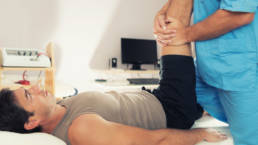What is Chiropractic?
Chiropractic is a healthcare profession that is very multifaceted, encompasses all ages by taking care of people from the cradle to the grave, and can help regain, restore, and maintain optimal health throughout a lifetime. This applies to patients of all ages. Chiropractic care is unlimited in its approach to wellness, given the many aspects of health the nerve system affects. What is becoming more evident in society today is the notion that we need to start taking better care of our bodies. We need to start eating better, exercising more, and keeping our bodies more balanced for enhanced health.
The expertise of the chiropractor is in checking the spine for misalignment that impair nerve system function, thereby affecting overall body function. These are called fixations which interfere with the nerves’ ability to transmit vital information from the brain to the rest of the body. The nervous system controls and coordinates the function of all the systems in the body: the circulatory, respiratory, digestive, hormonal, eliminative, and immune systems. This is why nerve interference can impair any aspect of health.
Chiropractors identify the need for, and utilize, gentle pressure techniques, called adjustments, in order to remove fixations. Fixations are characterized by
- Irregular bony mechanics or spinal effects of poor mechanics on pain misalignment
- Nerve imbalances, perception (nociception)
- Muscle irritation
- Tissue inflammation
- Degenerative wear
A chiropractic adjustment restores more appropriate sensory, motor, and neurological input at the receptors of joints which allows the body the ability to express a greater state of health and well-being.
By Dr. Cheran Ruben BChiro, BSc(Chiro)
References
Globe G, Morris C, Whalen W et al., What Does a Chiropractor Do “Chiropractic Management of Low Back Disorders: Report from a Consensus Process,” Journal of Manipulative and Physiological Therapeutics November/December 2008: 651-658.
Palmer DD, “The Science, Art, and Philosophy of Chiropractic,” Portland, Oreg.; Portland Printing House; 1910.
Bronfort G, Haas M, Evans R, et al. Effectiveness of manual therapies: the UK evidence report. Chiropractic & Osteopathy. 2010;18(3):1–33.
Related Posts
What are the Effects of Caffeine?
18 May 2017
Coffee is one of the world’s most popular beverages, served hot and cold. This article spells out research findings on the pros and cons of this drink. In this meta- analysis of prospective studies, the association between coffee consumption and the risk of cognitive decline and dementia are…
0 Comments5 Minutes
Best Chiropractic & Physiotherapy in Perth
7 February 2017
At Perth Wellness Centre, we work to the highest level of care to help you with your physical, chemical and mental well-being. Our dedicated team of chiropractors and physiotherapists provide the right therapies and treatment you need so you can feel your best.
0 Comments3 Minutes


